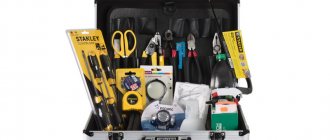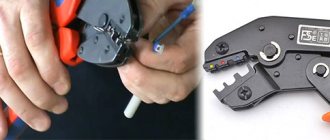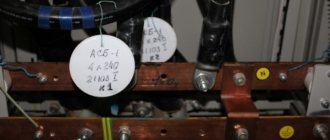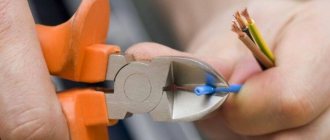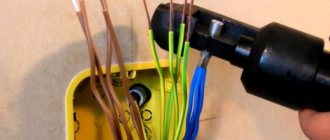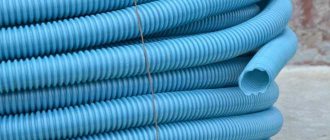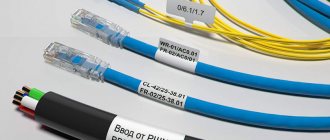SHARE ON SOCIAL NETWORKS
FacebookTwitterOkGoogle+PinterestVk
Crimping lugs for cables ensure a reliable and tight connection of cables, which is one of the conditions for the safe connection of household appliances to the electrical network. From this article you can learn in detail about all the features of these products, including their types, sizes and markings. The text provides an overview of double and single ferrule crimping technology, as well as products designed for connecting power cables.
Terminations for crimping are necessary for a reliable and safe connection
What is termination
Wire termination is one of the simplest and most reliable ways to connect wires to terminal blocks, circuit breakers and other electrical equipment. This type of connection is common in household and industrial networks. This is due to the advantages that termination allows to achieve:
- reliable contact patch;
- ease of installation;
- low connection resistance;
- general aesthetics of the wiring.
The main advantage of terminating cable cores is the low contact resistance of the resulting contact. If it is not used, the wire will not be able to properly press the screw onto the terminal block bus. This will cause the contact resistance to be too high. A bad connection will start to heat up or completely burn out.
Termination is done using tips. Externally, they resemble copper or aluminum caps. On one side, a wire pre-stripped of insulation is inserted into them, and on the other there is a hole for fastening with a screw. The tip serves as a reliable adapter between the cable and the device to which it is connected.
Stranded wire crimping
Why are they needed?
Wire lugs are needed to perform crimping of NShVI, to create reliable contact between several conductors, wires and busbars, or wires and clamps. Electrical contact in such a situation will be ensured by complete contact of the walls of the cable lug along the core diameter using a hammer or clamping using a screw device. They are also needed to simplify installation processes in electrical installations or to perform some technological operations.
Cable lugs for crimping
Cable lugs for automotive wires for crimping are designed to replace all kinds of twists and other types of connections that are common among poor installers. Such a device allows for optimal wire fixation inside the sleeve or a reliable conductor.
Crimping
Why do you need an ending?
The danger lies in excessive overheating of the connection point. Without termination, the contact will be unreliable. Such a compound will begin to heat up and become covered with a layer of oxide. The resulting oxide will further increase the contact resistance. At the connection point, an increasing amount of heat will begin to be released. The process is like growing a snowball. But the result is the same - the connection will burn out.
And it’s good if the conductor simply falls off from its proper place and that’s all over. In some cases, the cable insulation may ignite due to overheating and cause a fire. And a fallen wire can touch the grounded body of the installation or electrical panel and cause a short circuit.
How to terminate a wire without a ferrule
Using lugs is a convenient way to terminate wires. However, they are not always at hand. In this case, the cable is terminated without lugs. The current-carrying conductor, stripped of insulation and dirt, is manually bent into the shape of a ring (ear) under the bolt. To form the joint, use long-nose pliers with a rounded outside. The resulting connection is less reliable than the factory-made tip.
If the wire is copper, then the eye for the bolt can be tinned with solder. It is necessary to bend the ring in the direction of tightening the screw, so that during the tightening process the eyelet twists around the bolt, and not vice versa.
Additional Information. Modern aluminum wire is not flexible. Its strands are more fragile than those of copper cable. This should be remembered when terminating and forming connecting rings. Aluminum wire must be bent a minimum number of times.
Common types of tips
In electrical installation practice there are dozens of types of connectors. This diversity is due to the wide list of wires used. Each type of cable has its own tip. It must match the material and cross-section of the current-carrying conductor.
Important. To terminate aluminum wires, adapters made of the same material should be used. This rule also applies to copper conductors. Direct connection of copper with aluminum is unacceptable.
Copper tips TM
Manufactured from seamless tube. This is indicated by the letter - T. The tube is made of copper - M. The full marking looks like this: TM 35-10-9. Here:
- T - tube;
- M - copper;
- 35 - cross-section of the cable for which this tip is intended, sq. mm;
- 10 — diameter (grade) of the fastening screw, mm;
- 9 is the diameter of the shank, that is, the hole into which the cable core is inserted.
If dimensions allow, the tip model is indicated on its surface. If it is too small, then the nominal cross-section of the connected cable is stamped on the product body. For example, the number “4” next to the mounting hole means that a conductor with a cross-section of 4 square meters should be inserted into the tip. mm.
Copper with tinning TML
Copper is a good conductor of electric current. However, a greenish coating is often found on TM tips. This is a layer of copper oxide, which is no good for reliable current transmission. To combat this phenomenon, the tips are additionally coated with a protective anti-corrosion tin coating. The resulting product here means tinning. Otherwise, the TM and TML markings are similar.
Tinned wire lugs
The protective layer prevents oxidation of the copper tip. Therefore, it can be used in more humid areas. Due to increased reliability, TML is suitable for connecting critical electricity consumers.
Tinned copper with control window TML (o)
Before installing the current-carrying conductor into the tip, the protective insulation layer is removed from it. There are a couple of subtleties:
- The stripped core should completely enter the tube and rest against its end. There should be no void left in the tip cavity.
- The cable must be stripped to a minimum length. So that there is no exposed section of wire without insulation left at the tip shank.
To control the above conditions, TML (o) connectors are used. The small letter “o” at the end of the marking means that there is an inspection hole on the surface. The window allows you to visually assess whether the cable has reached the proper depth.
Aluminum TA tips
This type of connector is made of aluminum tube. This is indicated by the letter "A". TA lugs are designed for branching aluminum wires from busbars of similar material.
TAs have a long service life. Aluminum has increased resistance to moisture from the air and is practically not destroyed by it. This material is several times cheaper than copper, so sometimes people choose aluminum fasteners.
Aluminum cable lugs
TA are produced for wires with a cross-section of 16 square meters. mm and above. They also require the use of quartz-vaseline lubricant for additional surface protection.
Copper-aluminum TAM
The structure of these connectors uses two metals: copper and aluminum. They are connected to each other through frictional diffusion. One metal penetrates another at the molecular level. Therefore, high contact resistance is avoided.
TAMs have a unique property. They are used to connect aluminum cores to copper busbars of switchgears. Otherwise, they are no different from other tubular modifications. A screw is used to connect them, and compression is done using a press.
Other types of tips
The types of fasteners listed are not sufficient to perform all electrical tasks. Therefore, in practice, other types of tips are often found:
- PM - cable lugs for soldering. They are made from sheet copper grade M1. In addition to soldering, this type of tip is also suitable for crimping. Available for cables with cross-sections from 2.5 to 240 sq. mm.
- NShP - pin flat. Used to connect copper cables. Made of copper. The main purpose is to connect wiring to circuit breakers. Inside it has ring notches to improve contact with the current-carrying conductor.
- NShV - pin bushing. Common in modern equipment. Made of electrical copper with a protective coating. Used to connect multi-core copper wires with a cross-section from 0.25 to 150 square meters. mm.
- NSHVI - insulated pin bushing. Equipped with an additional insulating plastic skirt.
Wire lug crimping pliers
Terminal crimping pliers are used to firmly and reliably connect wires to each other or to terminals of various shapes and sizes. In this case, the crimping method is used, which is considered preferable to soldering.
This is especially true when using open-type electrical circuits, which are used in car assembly. Also, when connecting conductors using terminal crimping pliers, you must remember the galvanic couple effect.
The pliers presented in our store differ in the number of supported terminal sizes, the presence of devices for removing insulation, and the use of a conventional crimping or ratcheting mechanism, which allows for a more uniform force over the entire surface.
Wire crimping
- In order to properly crimp a wire, you must follow 3 main rules:
- First, choose the right connector or tip so that its size matches the cross-section of the wire being pressed.
- Secondly, use a professional tool. These are press pliers equipped with a ratcheting mechanism that will allow you to perform a full crimping cycle.
- And thirdly, select the desired matrix. Its geometry and shape must correspond to the crimp part of the tip.
Only stranded wires can be crimped with insulated lugs. Mono-core ones should be used for their type of non-insulated lugs.
When choosing, be sure to pay attention not only to the diameter and cross-section, but also to the shape of the contact blade. Do not use fork lugs on moving or vibration-prone contacts!
The insulation from the core is removed exactly to the length of the compressed tube where the core is inserted. Unlike bushings, it will be extremely inconvenient to bite off the excess with a cable cutter.
When crimping, insert the tip into the press matrix so that the seam of the shank is on top and strictly in the center.
Match the color coding on the dies to the colors of the tips themselves.
When pressing insulated tips with pliers, make sure that each circuit of the matrix is crimping its part of the core and insulation, and also insert the tip into the matrices only from the marked side.
If the dies are not completely closed at the end of clamping the handles, then you have selected the wrong tip size. If the insulating sleeve is damaged, the tip must be replaced.
The wires are inserted into the sleeve and crimped with a special tool - a crimper. A crimper is a crimping pliers. The great advantage of the sleeves is that such crimping does not create increased resistance at the connection point.
Crimpers can be used to work with solid or twisted wires. This crimping tool is also called a crimper. The advantage of crimping is the ability to replace jaws.
Finishing tools
To securely crimp the tube under the cable, you will have to use a special tool. Depending on the cable cross-section, it is divided into two categories:
- press pliers - for tips up to 10 sq. mm;
- hydraulic press - from 16 sq. mm and above.
Wire terminations ensure uniform crimping of the tube on at least four sides. This method allows you to achieve the best contact. The hydraulic press comes with compression attachments. They should be selected depending on the cross-section of the crimped tip.
Hydraulic press pliers for crimping lugs
Important! After crimping the tip, it should be protected from moisture from the air. Several layers of insulating PVC tape are wound around the area into which the wire is inserted. It is even more convenient to use heat-shrinkable tubing. Its color is selected in accordance with the purpose of the wire. Phase A - yellow, B - green, C - red.
Types
Although there is a common area of application for all tips, they are all divided into many types. The most common gradation is based on the material of manufacture, the shape of the end, and the method of installation.
According to the material of manufacture
Depending on the material of manufacture, there are aluminum cable lugs. The design is made of aluminum material and allows the connection of aluminum conductors.
Aluminum
Copper lugs are made from copper and are needed to terminate copper wires and subsequently connect them to the same conductive surfaces made of tin.
Aluminum-copper are created from several materials, made of plates in different combinations. Serve to connect copper and aluminum conductors and surfaces.
Aluminum-copper
By installation method
Another criterion for separating cable terminations is the installation method. There are three types of wire lugs.
So, there is crimping using an aluminum or copper tube. This is the fastest way to install a cable lug by crimping the cable sleeve using a special tool or pliers. But, using a non-specialized tool, you can get a bad crimp connection.
For crimping
There is tightening using screw clamps. There are classic breakaway bolts. The usual ones are classic cable couplings, where the conductor is clamped with one or more bolts. Breakaways are a disposable version of a bolt clamp.
For tightening with screw clamps
Soldering and welding are the third type of cable terminations according to the installation method. Soldering of the conductor tip is carried out with tin solder. Welding is done with the same metal as the current-carrying core by spot welding.
For soldering or welding
By shape
Depending on the shape of the edge of the cable lug, cable lugs are used in different devices and perform certain functions. Based on this criterion, there are tips:
- ring - products with one part of the tube or an open ring sleeve. The ring is needed to make a clamp under the bolt and ensure good contact over the entire area.
You might be interested in Cable and wire insulation
Ring
- horn with fork or hook - products, open on one side, for quickly disconnecting and connecting leads. Widely used to carry out tests.
Carob or hook
- connector - products with a classic connection.
Connector
- plate - products used to connect power cables to an electrical installation.
- plugs with sleeve tips - products placed in this connector.
- pin - models made in the form of a flat strip or a bent needle.
- tubular - elements used to splice several cores from a cable sleeve.
Each of the above types should be selected according to the tasks that need to be solved using a specific connection. But these are not the only criteria that need to be followed and used when choosing a specific model.
Soldering tips
Some tips require fastening by soldering. As a rule, these models are produced in tinned version. If the tip is designed for a small cross-section of up to 10 sq. mm, then it can be soldered using a regular soldering iron. If the tube is large, then you should use a gas burner. In this case, the conductor itself is first cleaned and tinned with tin-lead solder. The method is only suitable for copper lugs and cables. In terms of quality, such a connection is inferior only to welding.
Reliable connection of the cable requires termination of its cores. For large cross-section wires, lugs should be used. Thin ones can be terminated without them. To do this, just make a neat ring using long-nose pliers or pliers.
The tip is selected taking into account the material and cross-section of the current-carrying conductor. For high-quality termination, it is advisable to use a special press or assembly pliers. If they are absent or the amount of work is small, it is permissible to resort to soldering the tip.
How to choose the right terminals for wires
When choosing the most suitable cable lug, you need to be guided by the fact that the electrical conductor and sleeve correspond to the specified automatic parameters. This principle is relevant for any fixation, since when using a shank with a large diameter, there is free space that impairs contact.
There is no need to fill and crimp it with debris using wire or solder, as this may solve the problem. The plate is selected according to the diameter of the hole and the cross-section of the bolt or terminal. They are also chosen based on the quality of the core. If the crimped terminal and dielectric have a bare area, it may cause oxidation, fracture and fire.
Correspondence of diameter to bolt cross-section
